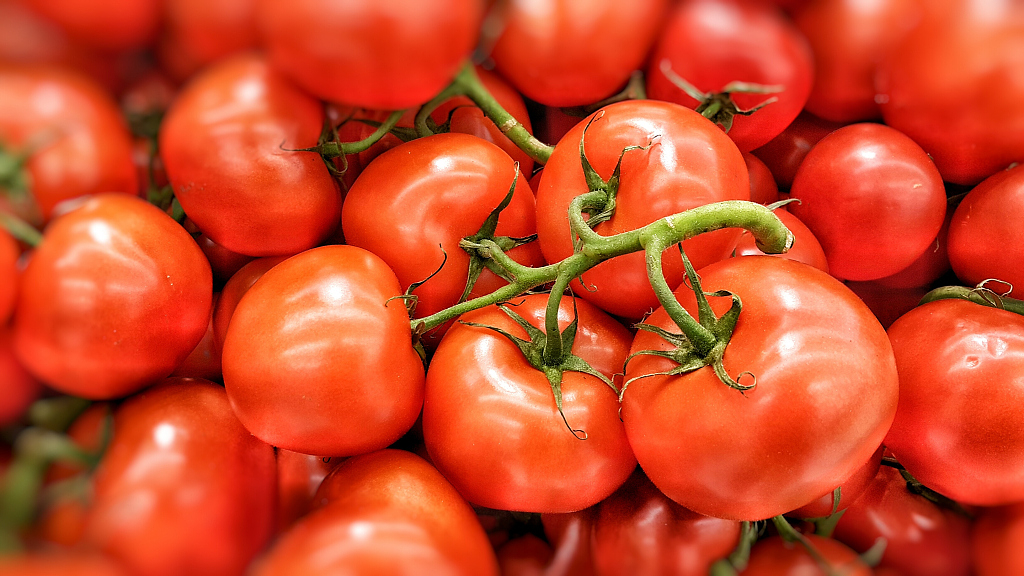When you squeeze ketchup generously onto your hamburger or french fries for lunch, you probably wouldn't relate this condiment, ubiquitous to Western dishes, with China. Surprisingly, one quarter of the world's ketchup comes from Xinjiang Uygur Autonomous Region in northwest China, thanks to the large amount of tomatoes planted here.
First cultivated in the Americas, the tomato went on its global journey after European explorers discovered it in the 16th century. In China, the tomato was introduced during the Ming Dynasty (1358 A.D.-1644 A.D.). However, the flamboyant red fruit (or vegetable, depending on who you ask) was mainly cultivated as an ornamental plant instead of food.

One spoonful of ketchup. /VCG Photo
One spoonful of ketchup. /VCG Photo
Tomatoes began appearing on people's tables in China in the late Qing Dynasty (1644 A.D.-1912 A.D.), but large cultivation of tomatoes only started in the past 50 years. Xinjiang's disparity between day and night temperatures and long hours of sunlight make it a great home for tomatoes to thrive.
In 2016, 92,000 hectares of tomatoes were planted in Xinjiang, and 9.18 million metric tons of tomatoes were harvested. One thing worth noting about Xinjiang's tomatoes is that they are less juicy and easier to store and transport. Thus, tomatoes here are more suitable to make ketchup.

Every year, more than 80 percent of ketchup produced in Xinjiang is exported to Russia and Italy. Thanks to a growing network of China-Europe cargo trains, it only takes half a month for Xinjiang's ketchup and other tomato products to reach European countries.
Apart from making tomato products like ketchup and diced tomatoes, tomatoes themselves are very nutritious. Tomatoes are 95 percent water, rich in vitamins and minerals, and their savory flavor makes them a key ingredient in various dishes around the world.

People dry tomatoes in northwest China's Xinjiang Uygur Autonomous Region. /VCG Photo
People dry tomatoes in northwest China's Xinjiang Uygur Autonomous Region. /VCG Photo

People dry tomatoes in northwest China's Xinjiang Uygur Autonomous Region. /VCG Photo
People dry tomatoes in northwest China's Xinjiang Uygur Autonomous Region. /VCG Photo

People dry tomatoes in northwest China's Xinjiang Uygur Autonomous Region. /VCG Photo
People dry tomatoes in northwest China's Xinjiang Uygur Autonomous Region. /VCG Photo
Though tomatoes did not originate in Xinjiang, the region's tomato products have traveled to over 80 countries and regions, making them an important link connecting China to the world via the new Silk Road.
China's Flora Tour
From the wetlands along the coast to the dense rainforests hidden in the southwest of China, all boast an array of plant species. In this series, CGTN will go on a tour to learn about some of the most iconic flora in different provinces and see how they live in harmony with the local climate and topography.
Read More:
China's Flora Tour: Xinjiang-Hami melon, a special tribute to the emperor
China's Flora Tour: Xinjiang-The 'white gold' on the ancient Silk Road
China's Flora Tour: Xinjiang-City famous for fragrant pears
China's Flora Tour: Xinjiang-What would spring be without apricot blossoms?
(Cover photo via VCG, designed by CGTN's Qu Bo.)
(If you want to contribute and have specific expertise, please contact us at nature@cgtn.com)